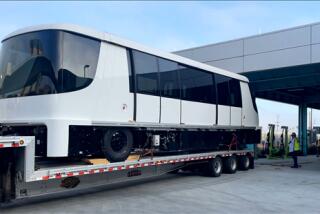Congestion, Potential Profit Spurs a Serious Look at the Maglev Train : Transit: U.S. corporations move to get in on the beginning of the new technology, prompted by the potential billions at stake.
- Share via
PITTSBURGH — Ultrafast trains that zip along on magnetic cushions seem a vision of a distant future, but corporate America is showing more and more interest in what many believe could become a viable U.S. industry in the next 20 years.
“It’s not a dream technology. It’s not the study of something yet to be invented,” said Philip Shucet, manager of planning, environment and traffic services at Michael Baker Corp., an engineering firm involved in developing the technology, known as magnetic levitation, or maglev.
Maglev trains have no wheels. Capable of traveling at speeds up to 310 m.p.h., they glide down a single-track guideway, elevated slightly and propelled forward by an electronically generated magnetic cushion. The trains’ sides are wrapped around the guideway rail, eliminating the possibility of derailment.
Researchers are also investigating the use of superconducting magnets in maglev.
Prototype maglev systems are operating in West Germany and Japan, and U.S. routes under study include Chicago-Milwaukee, Southern California-Las Vegas, Dallas-Houston and Pittsburgh-Cleveland.
A group of West German and Japanese companies plans to build a 20-mile system between Orlando International Airport and Disney World’s Epcot Center.
Maglev was conceived in the United States but developed in West Germany and Japan. The U.S. government stopped funding maglev development in 1975, slowing development here while West German and Japanese interests invested hundreds of millions of dollars in research.
But the government is reconsidering, maglev proponents say, prompted by expensive highway and airway congestion, a desire to promote public transportation, and by corporations interested in establishing an American presence in what is a potential $211-billion market.
Among other politicians, U.S. Sen. Daniel Patrick Moynihan (D-N.Y.) has become a major proponent of the technology and has developed a bill designed to encourage pension funds to invest in maglev.
Among companies in a coalition pushing for federal support for maglev are Grumman Corp., CSX Corp. and General Electric Co.
In Pittsburgh, corporations involved in developing a regional maglev system and promoting maglev manufacturing include Michael Baker, USX Corp. and AEG Westinghouse Transportation Systems Inc., a joint venture of AEG AG of West Germany and Westinghouse Electric Corp.
The companies would potentially build or supply maglev systems. “There is an obvious business perspective of being in on the ground floor of something new,” Shucet said.
Also involved is Transrapid International, a West German consortium that has developed what its advocates call the world’s most advanced maglev system.
Besides being designated for the Pittsburgh project, Tranrapid’s maglev is the technology chosen for Orlando’s.
And a consortium of 11 Japanese firms, headed by Mitsui & Co., has commited $250,000 to the project.
“A new transportation system is an essential factor for the success of the U.S. economy,” said Jitsuro Terashima, general manager of strategic information and corporate planning at Mitsui, at a press conference on the Pittsburgh plan.
Carnegie-Mellon University, whose support for a Pittsburgh software industry helped generate many of the city’s 60,000 high technology jobs, has also thrown its weight behind maglev.
“I think this is the way a university should participate in the economic development of a community,” Carnegie-Mellon president Richard Cyert said.
The university, the corporations and civic leaders have formed a corporation, Maglev Inc., to promote Pittsburgh as a manufacturing center for maglev components, and to build a 19-mile prototype system between downturn Pittsburgh and the city airport.
More to Read
Sign up for Essential California
The most important California stories and recommendations in your inbox every morning.
You may occasionally receive promotional content from the Los Angeles Times.













